
The Republic of Colombia is situated largely in the northwest of South America, with some territories falling within the boundaries of Central America. It is bordered to the northwest by Panama; to the east by Venezuela and Brazil; to the south by Ecuador and Peru; and it shares maritime limits with Costa Rica, Nicaragua, Honduras, Jamaica, the Dominican Republic, and Haiti.

The Andean condor is a South American bird in the New World vulture family Cathartidae and is the only member of the genus Vultur. Found in the Andes mountains and adjacent Pacific coasts of western South America, the Andean condor is the largest flying bird in the world by combined measurement of weight and wingspan. It has a maximum wingspan of 3.3 m and weight of 15 kg (33 lb). It is generally considered as the largest bird of prey in the world.

The spectacled bear, also known as the Andean bear, Andean short-faced bear, or mountain bear and locally as jukumari, ukumari (Quechua) or ukuku, is the last remaining short-faced bear. Its closest relatives are the extinct Florida spectacled bear, and the giant short-faced bears of the Middle to Late Pleistocene age. Spectacled bears are the only surviving species of bear native to South America, and the only surviving member of the subfamily Tremarctinae. The species is classified as Vulnerable by the IUCN because of habitat loss.

Carl Troll, was a German geographer, brother of botanist Wilhelm Troll. From 1919 until 1922 Troll studied biology, chemistry, geology, geography and physics at the Universität in München. In 1921 he obtained his doctorate in botany and in 1925 his habilitation in geography. Between 1922 and 1927 he worked as an assistant at the Geography Institute in Munich. Troll was engaged in research in the ecology and geography of mountainous lands: between 1926 and 1929 went on a research journey throughout South American Andean countries where he visited northern Chile, Bolivia, Peru, Ecuador, Colombia, and Panama. In 1933 and 1934 his research interests took him to East and South Africa; in 1937 Troll was in Ethiopia; and in 1954 he visited Mexico.

Páramo can refer to a variety of alpine tundra ecosystems located in the Andes Mountain Range, South America. Some ecologists describe the páramo broadly as "all high, tropical, montane vegetation above the continuous timberline". A narrower term classifies the páramo according to its regional placement in the northern Andes of South America and adjacent southern Central America. The páramo is the ecosystem of the regions above the continuous forest line, yet below the permanent snowline. It is a "Neotropical high mountain biome with a vegetation composed mainly of giant rosette plants, shrubs and grasses". According to scientists, páramos may be "evolutionary hot spots" and among the fastest evolving regions on Earth.
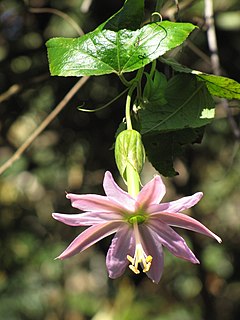
Passiflora tarminiana is a species of passionfruit. The yellow fruits are edible and their resemblance to small, straight bananas has given it the name banana passionfruit in some countries. It is native to the uplands of tropical South America and is now cultivated in many countries. In Hawaii and New Zealand it is now considered an invasive species. It was given the name banana passionfruit in New Zealand, where passionfruit are also prevalent. In Hawaii, it is called banana poka. In its Latin American homeland, it is known as curuba, curuba de Castilla, or curuba sabanera blanca (Colombia); taxo, tacso, tagso, tauso (Ecuador); parcha, taxo (Venezuela), tumbo or curuba (Bolivia); tacso, tumbo, tumbo del norte, trompos, tintin or purpur (Peru).

The Andean Parliament is the governing and deliberative body of the Andean Community. It was created on October 25, 1979 in La Paz (Bolivia), through the Constitutive Treaty signed by the chancellors of Bolivia, Colombia, Ecuador, Peru and Venezuela. It entered into force in January 1984.
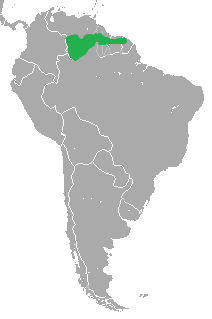
The Guianan white-eared opossum is an opossum species from South America. It is found in Brazil, Suriname, French Guiana and Venezuela.

The dark long-tongued bat is a species of bat from South and Central America. It was formerly considered monotypic within the genus Lichonycteris, but is now recognized as one of two species in that genus, along with the pale brown long-nosed bat. It is small species of bat, with adults weighing 6–11 g (0.21–0.39 oz) and having a total length of 46–63 mm (1.8–2.5 in).

Pristimantis taeniatus is a species of frog in the family Craugastoridae. It is found in central Panama to Colombia, possibly to northwestern Ecuador. It is sometimes known as banded robber frog.

The cloud-forest pygmy owl is a short, muscular, small-sized species of owl found throughout the Andes of western Colombia and north-western Ecuador, being confined to cloud forests between 900–2000 m a.s.l. Below this altitudinal range the Central American pygmy owl occurs; above it, the Andean pygmy owl occurs.
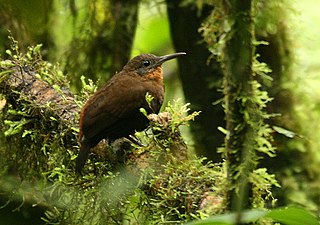
The tawny-throated leaftosser is a tropical American bird species in the ovenbird family Furnariidae. It is also known as the tawny-throated leafscraper, Mexican leaftosser or Mexican leafscraper. This bird might be a cryptic species complex.
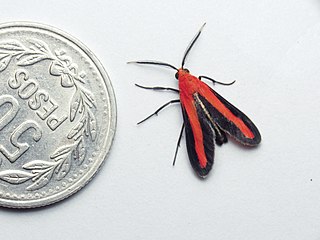
Tipulodes is a genus of moths in the subfamily Arctiinae, which currently contains 3 species. The genus was described by Boisduval in 1832. The genus is described as "Small Arctiids with relatively narrow wings. Ground colour brownish black with characteristic wings patterns. Forewing with elongate rusty-red blotch from the base almost to the apex, hindwing with rusty-red stripe along the costal edge; underside of wings similarly coloured. Males with coremata forming membranous tubes, much longer than abdomen when everted, covered with hairs along the whole length"

The Andean porcupine or Quichua porcupine is a species of rodent in the family Erethizontidae. It is found in the Andes of northern Ecuador and Colombia as well as in Panama. This porcupine is little known, but is probably arboreal, nocturnal and solitary like its relatives. The species is thought to be uncommon to rare and the population decreasing. It is threatened by deforestation, habitat fragmentation and agriculture.

Ripart's anomalous blue is a butterfly in the family Lycaenidae.

Quercus humboldtii, commonly known as the Andean oak, Colombian oak or roble, is a species of oak in the beech family found only in Colombia and Panamá. It is named for Alexander von Humboldt. It grows in the mountains with an altitudinal range from 1,000 to 3,200 m. It is found on all three Colombian Andean mountain ranges and some lowland inter-Andean regions.
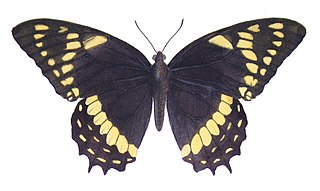
Papilio menatius is a butterfly of the family Papilionidae.

The Andean motmot or highland motmot is a colorful near-passerine bird found from northern Colombia to western Bolivia.

The Santa Marta páramo (NT1007) is an ecoregion containing páramo vegetation above the treeline in the Sierra Nevada de Santa Marta mountain range on the Caribbean coast of Colombia. The isolated position of the range has allowed unique species to evolve. Some are related to those found in Central America and the Caribbean coastal areas, and some to species from the Andes. The habitat is relatively stable, but has been drastically changed from the original by long-term human activity.

The Cauca Valley montane forests (NT0109) is an ecoregion in western Colombia. It covers the sides of the Cauca Valley, which runs from south to north between the Central and Western Ranges (cordilleras) of the Colombian Andes. The ecoregion is home to very diverse fauna and flora, due in part to its varied elevations and climates, in part to its position near the isthmus of Panama, the route along which North American species invaded South America and then diversified as they moved to the upper parts of the Andes. Little of the original habitat remains at lower levels, but higher up there are sizeable blocks of forest, some of which are protected.




















